Each month will feature a new apple. You can find photos, history, pollination date, harvest date, flavor profile, susceptibility to disease, and other facts.
The January featured apple is Williams Pride
 History–The Williams’ Pride apple was developed by a research team at Purdue, Rutgers, and Illinois Universities in the 1970s and released to the public in 1988. The apple is named after Edwin Williams, who led the team and selected the variety in 1979.
History–The Williams’ Pride apple was developed by a research team at Purdue, Rutgers, and Illinois Universities in the 1970s and released to the public in 1988. The apple is named after Edwin Williams, who led the team and selected the variety in 1979.
Attributes–Great flavor, good keeping, early harvest, and good disease resistant are hallmarks of this apple. The flesh is crisp and juicy and may be stained a bit red.
Harvest–William’s Pride is a summer apple that ripens in late July or early August.
Taste–William’s Pride is known for its sweet spicy taste. I have some nice grafts, but no apples yet.
Resistance–Resistant to scab, fireblight, and cedar apple rust, this is an excellent choice for a no spray orchard.
The December featured apple is Glockenapfel
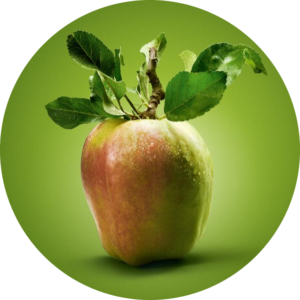
Alternate Names: Bell apple, Prinzenapfel
History: The origin of Glockenapfel is unknown, but it probably originated in Switzerland or Germany

Attributes: Glockenapfel has a unique bell shape with a slight waist. It has green smooth skin with red blush and a transluscent quality.
Harvest: Mid to late October
Taste:![]() A refreshing lemony taste. It is prized as a cooking apple, especially for strudel. It keeps its shape well.
A refreshing lemony taste. It is prized as a cooking apple, especially for strudel. It keeps its shape well.
Resistance: The Glockenapfel apple tree is scab resistant. The apples are also resistant to cedar apple rust, fireblight, and mildew.
The November featured apple is Goldrush
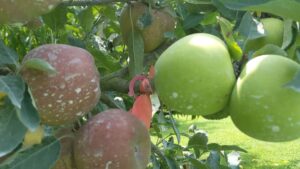
This photo features Goldrush and Red Delicious in mid summer. The white spots are from Surround, the organic insect deterrent spray.
Alternate Names:
History: Goldrush came from Purdue in 1992, one of the best scab-immune varieties released to date. A cross between Golden Delicious and a number of experimental varieties.
Attributes: It is one of the latest hanging apples and retains its crunch for many months in storage.
Flavor: Goldrush retains the taste of Golden Delicious with an additional spicy punch. The flavor mellows somewhat over time, but retains a bit of acid compared to its parent Golden Delicious.
Resistance: Goldrush is remarkably scab free and often one of the most clear apples in the orchard. The photo above shows just how perfect the apples look in early August.
Harvest: Goldrush can hang on the tree well into the first hard freeze, often late October to November. The color changes from green to yellow as it ripens. I picked mine in mid October just before the first frost, but it was probably a bit too soon.
The October featured apple is Summer Banana.
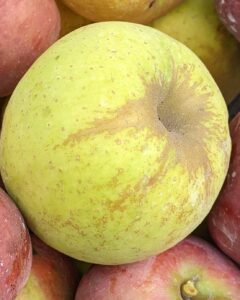
Alternate Names:
History: This apple is from Marion County, South Carolina and was first grown in the late 1800’s. The fruit was sold from 1890 to 1925, by two North Carolina nurseries and was trademarked about 1900 by the J. Van Lindley Nursery of Greensboro: “We paid $75 for the original tree and control of the same.”. It is so named because it can have a banana aroma when fully ripe. Many tales are told of this apple being the choice of tobacco laborers during their brief breaks from the fields.
Attributes: The Summer Banana’s fruit is usually medium in size, a deep yellow with small light green splotches and perhaps a few red dots at its peak of ripeness. The Summer Banana apples in my orchard had a papery russet feel and a splash of russet on top.
Flavor: I found this apple to have a wonderful refreshing taste that was both sweet, balanced with acid, and complex. I did not detect the banana aroma that has been suggested.
Resistance: Perhaps owing to it’s russet feel, this was one of the most clear and pest resistant apples this year. The apples hung for weeks with no drop or bird pecks.
Harvest: Harvest is usually late August to early September. The apples hung on the tree for a full three weeks without any noticable change in texture or taste.
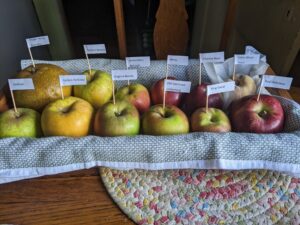
The September featured apple is Red Delicious

Alternate Names: Delicious, Hawkeye
History: The most recognized apple in America has quite a history lurking behind it. It began as a sprout found growing under a Yellow Bellflower apple on a farm in Iowa. As the story goes, Jesse Hiatt cut it down multiple times, but the apple persisted. Taking it as a sign, he finally left the tiny tree to grow and flourish. The taste was sweet and mild, and Hiatt decided to enter his new variety he named “Delicious” into a Stark Brother’s contest to find the best new apple. After several tries, Stark contacted Hiatt and bought the rights to the apple. And the rest, as they say, is history.

Attributes: It is beautiful, tall and strikingly red. The apple sits upon five distinctive lobes, a familiar site in my orchard that always makes me smile. The shape is conical and unmistakable.
Harvest: Red delicious is usually ripe in late August or early September.
Taste:![]() America’s favorite apple has a mild, sweet taste, with no discernable acid. More often than not, it is rather bland, and has been replaced in popularity by some of the newer apples today. The skin is normally quite thick and glossy. Despite the thick skin, it is often eaten fresh off the tree.
America’s favorite apple has a mild, sweet taste, with no discernable acid. More often than not, it is rather bland, and has been replaced in popularity by some of the newer apples today. The skin is normally quite thick and glossy. Despite the thick skin, it is often eaten fresh off the tree.
Resistance: In my orchard, this apple is one of the more clear and perfect ones. It’s thick skin seems to ward off many pests, although the bright red color can be a beacon to birds to peck.
This year, I sampled a few dropped apples, and the one shown on the bottom of the photo seemed particularly ribbed and short in stature. My fruit friends suggested that it looked more like the Hawkeye, or the original red delicious apple.

The July/August featured apple is Bevan’s Favorite.

Alternate names: Early Bevans, Striped June, and Bivins.
History: Though often considered an apple from the Deep South of the United States, Bevan’s Favorite actually originated in Salem in Salem County, New Jersey during the first half of the 1800s. It was widely grown in the southern United States, but slowly faded away in the early 1900s. Lee Calhoun, author of “Old Southern Apples” (published 1995, 2011) undertook the search for this cultivar and discovered a lone tree in 1985 in Alamance County, North Carolina. It is once again available at select nurseries in the U.S.A. https://pomiferous.com/applebyname/bevans-favorite-id-733 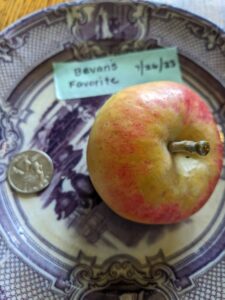
Attributes: Bevan’s favorite is a medium sized apple. Stripes of red often overlay a yellow base, with more color visible on the side closest to the sun. Bevan’s Favorite, like most early apples, does not keep well. It starts to go soft within days of harvest.
Harvest: An early apple, often ripe by mid-July, Bevan’s favorite is a welcomed treat at the beginning of the harvest season. Early ripening has it’s advantages
Bevan’s Favorite avoids many of the late season pests and diseases that plague late season apples.
The skin is thin and crisp. Compared to “keeper” apples with their thick outer skin, Bevan’s favorite is a joy to eat.
There are relatively few apples ready to harvest at this early period.
This year in 6B, the first Bevan’s favorite was ripe about July 25. This is about two weeks later than the previous year.
Taste: Bevan’s Favorite has a sweet/tart refreshing taste.
Resistance: This apple has a good resistance profile, and is not plagued by late season diseases like sooty blotch or flyspeck. I have had good luck with this apple regarding the usual problems like fireblight, scab, or cedar apple rust.
![]()
